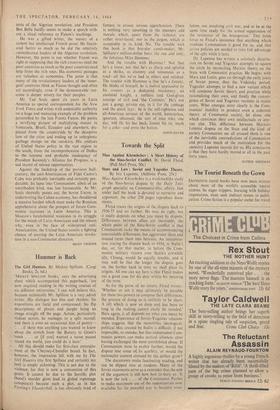The Tourist Beneath the Gown
DEFINITIVE travel books have now been written about most' of the world's accessible tourist centres. So eager trippers, bursting with holiday impressions, must seek indirect routes to publi- cation. Crime fiction is a popular outlet for travel
anecdotes. Detail is important to the detective and it's a short step from factual description to local colour.
America attracts a special kind of tourist thriller. Unlike that of a decadent old Europe, the local colour is strictly modern in flavour. Highways are central to -the mythology: comic road signs and outlandish vocabulary have be- come the recognised joke material. Creative writing courses give a popular excuse for respect- able young Britons to change overnight into slick amateur sleuths.
James Byrom is laudably restrained about Americana in Thou Shouldst be Living Yet (Heinemann, 18s.). His Scots hero Campbell plans an historical novel about his grandfather, a soldier of fortune who fought in the Civil War. A teaching job at a small American university encourages him to pursue his investigations. Then the chief researcher has an accident and the sus- picion of murder brings some venomous local feuds to light. Then Campbell is threatened. He cannot guess why his family history should still need such desperate camouflage. At Campbell's lectures, four students sit knitting pink sweaters Lefargically below him. They fail to appreciate his jokes about the French Revolution. Suspense and comedy contribute to this excellent picture of the amiable cranks and fiercely scheming .careerists in a quietly seething community.
Mr. Morse was shot dead in his secret love- nest. Everyone knew that his marriage had been hollow from the start, so his wife was the ob- vious suspect. At the beginning of Monkey on a Chain, by Edwin Lanham (Gollancz, 15s.), Dora Morse finds herself deserted by all her friends, except for the married men in search of an easy lay. Dora is worried and lonely and she is bothered by the persistent bullying of a detective who hopes to scare her into admitting her guilt. Her analyst persuades her to try group therapy as a forum for discussing her predicament. How the group solves the mystery makes exciting and immensely interesting reading. The amateur sleuths work with a peculiar kind of harmony. Open discussion of their neuroses has made them defenceless with one another, but they share an intimacy which is not normal in working relation-
elation-
ships. The friendly joviality of most detective partnerships is replaced by intense personal in- volvement. The method shows detection in a new and fascinating light.
We Sassenachs still know how to cheat the Scots. In A Legal Fiction, by Elizabeth Ferrars (Crime Club, 13s. 6d.), a picture stolen from a Scottish family is sold on the open market in England and becomes the property of its buyer. Thus, thanks to a legal quibble, it is possible for two different owners to possess the same property at the same time. Young Ginny, niece of the deprived family, recognises the missing portrait in the sale room and determines to get it back. She enlists the help of her cousin and they discover that the despised old canvas is really immensely valuable. Plans to recover the picture are tricky and the situation gets quite out of hand when a couple of murders are com- mitted. The story meanders on in Miss Ferrars's usual chatty way. Her trio of cranky aunts promises well, but they are disappointingly ordinary.
Douglas Warner's Death of a Dreamer (Cas- sell, 15s.) gives a frightening picture of the organised crime that suppurates on the surface of big cities. A young doctor who has caused a woman's death by incorrect diagnosis moves miserably to London and broods in a bed- sitter. The drug-pushers bully and humiliate him until he gets hooked on heroin. When he is in volved in a police raid, they drive him to suicide by cutting off supplies. Occasional 'ponderous writing gets forgotten in the packed excitement of this authentic gangster story.
Five young people spend Christmas together on a lonely Connecticut farm in Taylor Caldwell's first thriller The Late Clara Beame (Crime Club, 15s.). Storms sever communication with the out- side world and a chilly tension builds up within the group. The Christmas gaiety becomes rather hollow as mutual suspicion intensifies. The murderer has rather a good line in accidents, but 1 am sorry that the author thought it ,necessary to introduce a ghost. The intrusion of the super- natural lends absurdity to an otherwise plausible and exciting story. Romance neatly ties up loose



































 Previous page
Previous page